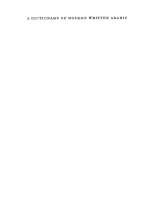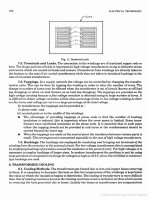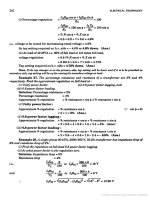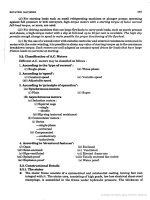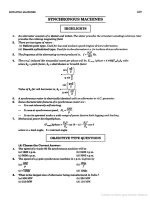A textbook of modern toxicology
Bạn đang xem bản rút gọn của tài liệu. Xem và tải ngay bản đầy đủ của tài liệu tại đây (6.33 MB, 582 trang )
A TEXTBOOK OF MODERN
TOXICOLOGY
THIRD EDITION
Edited by
Ernest Hodgson
Department of Environmental
and Biochemical Toxicology
North Carolina State University
A JOHN WILEY & SONS, INC., PUBLICATION
A TEXTBOOK OF MODERN
TOXICOLOGY
THIRD EDITION
A TEXTBOOK OF MODERN
TOXICOLOGY
THIRD EDITION
Edited by
Ernest Hodgson
Department of Environmental
and Biochemical Toxicology
North Carolina State University
A JOHN WILEY & SONS, INC., PUBLICATION
Copyright 2004 by John Wiley & Sons, Inc. All rights reserved.
Published by John Wiley & Sons, Inc., Hoboken, New Jersey.
Published simultaneously in Canada.
No part of this publication may be reproduced, stored in a retrieval system, or transmitted in any
form or by any means, electronic, mechanical, photocopying, recording, scanning, or otherwise,
except as permitted under Section 107 or 108 of the 1976 United States Copyright Act, without
either the prior written permission of the Publisher, or authorization through payment of the
appropriate per-copy fee to the Copyright Clearance Center, Inc., 222 Rosewood Drive, Danvers,
MA 01923, 978-750-8400, fax 978-646-8600, or on the web at www.copyright.com. Requests to the
Publisher for permission should be a ddressed to the Permissions Department, John Wiley & Sons,
Inc., 111 River Street, Hoboken, NJ 07030, (201) 748-6011, fax (201) 748-6008.
Limit of Liability/Disclaimer of Warranty: While the publisher a nd author have used their best
efforts in preparing this book, they make no representations or warranties with respect to the
accuracy or completeness of the contents of this book and specifically disclaim any implied
warranties of merchantability or fitness for a particular purpose. No warranty may be created or
extended by sales representatives or written sales materials. The advice and strategies contained
herein may not be suitable for your situation. You should consult with a professional where
appropriate. Neither the publisher nor author shall be liable for any loss of profit or any other
commercial damages, including but not limited to special, incidental, consequential, or other
damages.
For general information on our other products and services please contact our Customer Care
Department within the U.S. at 877-762-2974, outside the U.S. at 317-572-3993 or fax 317-572-4002.
Wiley also publishes its books in a variety of electronic formats. Some content that appears in print,
however, may not be available in e lectronic format.
Library of Congress Cataloging-in-Publication Data:
Hodgson, Ernest, 1932–
A textbook of modern toxicology / Ernest Hodgson.—3rd ed.
p. cm.
Includes bibliographical references and index.
ISBN 0-471-26508-X
1. Toxicology. I. Title.
RA1211.H62 2004
615.9—dc22 2003017524
Printed in the United States of America.
10987654321
CONTENTS
Preface xix
Contributors xxi
I Introduction 1
1 Introduction to Toxicology 3
Ernest Hodgson
1.1 Definition and Scope, Relationship to Other Sciences, and History 3
1.1.1 Definition and Scope 3
1.1.2 Relationship to Other Sciences 8
1.1.3 A Brief History of Toxicology 8
1.2 Dose-Response Relationships 10
1.3 Sources of Toxic Compounds 10
1.3.1 Exposure Classes 11
1.3.2 Use Classes 11
1.4 Movement of Toxicants in the Environment 11
Suggested Reading 12
2 Introduction to Biochemical and Molecular Methods in Toxicology 13
Ernest Hodgson, Gerald A. LeBlanc, Sharon A. Meyer, and Robert C. Smart
2.1 Introduction 13
2.2 Cell Culture Techniques 13
2.2.1 Suspension Cell Culture 14
2.2.2 Monolayer Cell Culture 14
2.2.3 Indicators of Toxicity in Cultured Cells 14
2.3 Molecular Techniques 16
2.3.1 Molecular Cloning 17
2.3.2 cDNA and Genomic Libraries 17
2.3.3 Northern and Southern Blot Analyses 18
2.3.4 Polymerase Chain Reaction (PCR) 18
2.3.5 Evaluation of Gene Expression, Regulation, and Function 19
2.4 Immunochemical Techniques 19
Suggested Reading 22
3 Toxicant Analysis and Quality Assurance Principles 23
Ross B. Leidy
3.1 Introduction 23
3.2 General Policies Related to Analytical Laboratories 23
v
vi CONTENTS
3.2.1 Standard Operating Procedures (SOPs) 24
3.2.2 QA/QC Manuals 24
3.2.3 Procedural Manuals 24
3.2.4 Analytical Methods Files 25
3.2.5 Laboratory Information Management
System (LIMS) 25
3.3 Analytical Measurement S ystem 26
3.3.1 Analytical Instrument Calibration 26
3.3.2 Quantitation Approaches and Techniques 26
3.4 Quality Assurance (QA) Procedures 27
3.5 Quality Control (QC) Procedures 27
3.6 Summary 28
Suggested Reading 28
II Classes of Toxicants 31
4 Exposure Classes, Toxicants in Air, Water, Soil, Domestic and
Occupational Settings 33
W. Gregory Cope
4.1 Air Pollutants 33
4.1.1 History 33
4.1.2 Types of Air Pollutants 34
4.1.3 Sources of Air Pollutants 35
4.1.4 Examples of Air Pollutants 36
4.1.5 Environmental Effects 38
4.2 Water and Soil Pollutants 40
4.2.1 Sources of Water and Soil Pollutants 40
4.2.2 Examples of Pollutants 41
4.3 Occupational Toxicants 44
4.3.1 Regulation of Exposure Levels 44
4.3.2 Routes of Exposure 45
4.3.3 Examples of Industrial Toxicants 46
Suggested Reading 48
5 Classes of Toxicants: Use Classes 49
W. Gregory Cope, Ross B. Leidy, and Ernest Hodgson
5.1 Introduction 49
5.2 Metals 49
5.2.1 History 49
5.2.2 Common Toxic Mechanisms and Sites of Action 50
5.2.3 Lead 51
5.2.4 Mercury 52
5.2.5 Cadmium 52
5.2.6 Chromium 53
5.2.7 Arsenic 53
5.2.8 Treatment of Metal Poisoning 54
CONTENTS vii
5.3 Agricultural Chemicals (Pesticides) 54
5.3.1 Introduction 54
5.3.2 Definitions and Terms 55
5.3.3 Organochlorine Insecticides 57
5.3.4 Organophosphorus Insecticides 58
5.3.5 Carbamate Insecticides 60
5.3.6 Botanical Insecticides 60
5.3.7 Pyrethroid Insecticides 61
5.3.8 New Insecticide C lasses 61
5.3.9 Herbicides 62
5.3.10 Fungicides 63
5.3.11 Rodenticides 63
5.3.12 Fumigants 64
5.3.13 Conclusions 64
5.4 Food Additives and Contaminants 64
5.5 Toxins 65
5.5.1 History 65
5.5.2 Microbial Toxins 66
5.5.3 Mycotoxins 66
5.5.4 Algal Toxins 67
5.5.5 Plant Toxins 68
5.5.6 Animal Toxins 68
5.6 Solvents 70
5.7 Therapeutic Drugs 70
5.8 Drugs of Abuse 71
5.9 Combustion Products 71
5.10 Cosmetics 71
Suggested Reading 73
III Toxicant Processing In vivo 75
6 Absorption and Distribution of Toxicants 77
Ronald E. Baynes and Ernest Hodgson
6.1 Introduction 77
6.2 Cell Membranes 78
6.3 Mechanisms of Transport 80
6.3.1 Passive Diffusion 80
6.3.2 Carrier-Mediated Membrane Transport 83
6.4 Physicochemical Properties Relevant
to Diffusion 85
6.4.1 Ionization 86
6.4.2 Partition Coefficients 87
6.5 Routes of Absorption 88
6.5.1 Extent of Absorption 88
6.5.2 Gastrointestinal Absorption 89
6.5.3 Dermal Absorption 91
6.5.4 Respiratory Penetration 94
viii CONTENTS
6.6 Toxicant Distribution 97
6.6.1 Physicochemical Properties and Protein B inding 97
6.6.2 Volume of Distribution (V
d
) 103
6.7 Toxicokinetics 105
Suggested Reading 109
7 Metabolism of Toxicants 111
Randy L. Rose and Ernest Hodgson
7.1 Introduction 111
7.2 Phase I Reactions 112
7.2.1 The Endoplasmic Reticulum, Microsomal Preparation, and
Monooxygenations 112
7.2.2 The Cytochrome P450-Dependent Monooxygenase System 113
7.2.3 The Flavin-Containing Monooxygenase (FMO) 128
7.2.4 Nonmicrosomal Oxidations 130
7.2.5 Cooxidation by Cyclooxygenases 132
7.2.6 Reduction Reactions 133
7.2.7 Hydrolysis 135
7.2.8 Epoxide Hydration 135
7.2.9 DDT Dehydrochlorinase 136
7.3 Phase II Reactions 137
7.3.1 Glucuronide Conjugation 138
7.3.2 Glucoside Conjugation 139
7.3.3 Sulfate Conjugation 139
7.3.4 Methyltransferases 141
7.3.5 Glutathione S-Transferases (GSTs) and Mercapturic Acid
Formation 143
7.3.6 Cysteine Conjugate β-Lyase 145
7.3.7 Acylation 145
7.3.8 Phosphate Conjugation 148
Suggested Reading 148
8 Reactive Metabolites 149
Randy L. Rose and Patricia E. Levi
8.1 Introduction 149
8.2 Activation Enzymes 150
8.3 Nature and Stability of Reactive Metabolites 151
8.3.1 Ultra-short-lived Metabolites 151
8.3.2 Short-lived Metabolites 152
8.3.3 Longer-lived Metabolites 152
8.4 Fate of Reactive Metabolites 153
8.4.1 Binding to Cellular Macromolecules 153
8.4.2 Lipid Peroxidation 153
8.4.3 Trapping and Removal: Role of Glutathione 153
8.5 Factors Affecting Toxicity of Reactive Metabolites 154
8.5.1 Levels of Activating Enzymes 154
CONTENTS ix
8.5.2 Levels of Conjugating Enzymes 154
8.5.3 Levels of Cofactors or Conjugating Chemicals 154
8.6 Examples of Activating Reactions 154
8.6.1 Parathion 155
8.6.2 Vinyl Chloride 155
8.6.3 Methanol 155
8.6.4 Aflatoxin B
1
156
8.6.5 Carbon Tetrachloride 156
8.6.6 Acetylaminofluorene 157
8.6.7 Benzo(a)pyrene 158
8.6.8 Acetaminophen 158
8.6.9 Cycasin 159
8.7 Future Developments 160
Suggested Reading 161
9 Chemical and Physiological Influences on Xenobiotic
Metabolism 163
Randy L. Rose and Ernest Hodgson
9.1 Introduction 163
9.2 Nutritional Effects 163
9.2.1 Protein 163
9.2.2 Carbohydrates 164
9.2.3 Lipids 164
9.2.4 Micronutrients 164
9.2.5 Starvation and Dehydration 165
9.2.6 Nutritional R equirements in Xenobiotic Metabolism 165
9.3 Physiological Effects 166
9.3.1 Development 166
9.3.2 Gender Differences 168
9.3.3 Hormones 169
9.3.4 Pregnancy 171
9.3.5 Disease 171
9.3.6 Diurnal Rhythms 172
9.4 Comparative and Genetic Effects 172
9.4.1 Variations Among Taxonomic Groups 173
9.4.2 Selectivity 181
9.4.3 Genetic Differences 181
9.5 Chemical Effects 184
9.5.1 Inhibition 185
9.5.2 Induction 190
9.5.3 Biphasic Effects: Inhibition and Induction 199
9.6 Environmental Effects 199
9.7 General Summary and Conclusions 201
Suggested Reading 201
10 Elimination of Toxicants 203
Gerald A. LeBlanc
10.1 Introduction 203
x CONTENTS
10.2 Transport 205
10.3 Renal Elimination 205
10.4 Hepatic Elimination 207
10.4.1 Entero-hepatic Circulation 208
10.4.2 Active Transporters of the Bile
Canaliculus 209
10.5 Respiratory Elimination 210
10.6 Conclusion 210
Suggested Reading 211
IV Toxic Action 213
11 Acute Toxicity 215
Gerald A. LeBlanc
11.1 Introduction 215
11.2 Acute Exposure and Effect 215
11.3 Dose-response Relationships 217
11.4 Nonconventional Dose-response Relationships 219
11.5 Mechanisms of Acute Toxicity 220
11.5.1 Narcosis 220
11.5.2 Acetylcholinesterase Inhibition 220
11.5.3 Ion Channel Modulators 222
11.5.4 Inhibitors of Cellular Respiration 223
Suggested Reading 224
12 Chemical Carcinogenesis 225
Robert C. Smart
12.1 General Aspects of Cancer 225
12.2 Human Cancer 228
12.2.1 Causes, Incidence, and Mortality Rates of Human Cancer 228
12.2.2 Known Human Carcinogens 231
12.2.3 Classification of Human Carcinogens 233
12.3 Classes of Agents Associated with Carcinogenesis 236
12.3.1 DNA-Damaging Agents 237
12.3.2 Epigenetic Agents 239
12.4 General Aspects of Chemical Carcinogenesis 240
12.5 Initiation-Promotion Model for Chemical Carcinogenesis 241
12.6 Metabolic Activation of Chemical Carcinogens and DNA Adduct
Formation 243
12.7 Oncogenes 245
12.7.1 Mutational Activation of Proto-oncogenes 245
12.7.2 Ras Oncogene 246
12.8 Tumor Suppressor Genes 247
12.8.1 Inactivation of Tumor Suppressor Genes 247
12.8.2 p53 Tumor Suppressor Gene 247
12.9 General Aspects of Mutagenicity 248
CONTENTS xi
12.10 Usefulness and Limitations of Mutagenicity Assays for the
Identification of Carcinogens 249
Suggested Reading 250
13 Teratogenesis 251
Stacy Branch
13.1 Introduction 251
13.2 Principles of Teratology 251
13.3 Mammalian Embryology Overview 252
13.4 Critical Periods 255
13.5 Historical Teratogens 256
13.5.1 Thalidomide 256
13.5.2 Accutane (Isotetrinoin) 256
13.5.3 Diethylstilbestrol (DES) 256
13.5.4 Alcohol 257
13.5.5 “Non Chemical” Teratogens 257
13.6 Testing Protocols 257
13.6.1 FDA Guidelines for Reproduction Studies for Safety
Evaluation of Drugs for Human Use 258
13.6.2 International Conference of Harmonization (ICH) of
Technical R equirements for Registration of
Pharmaceuticals for Human Use (ICH)—US FDA, 1994 258
13.6.3 Alternative Test Methods 259
13.7 Conclusions 259
Suggested Reading 259
V Organ Toxicity 261
14 Hepatotoxicity 263
Ernest Hodgson and Patricia E. Levi
14.1 Introduction 263
14.1.1 Liver Structure 263
14.1.2 Liver Function 263
14.2 Susceptibility of the Liver 264
14.3 Types of Liver Injury 264
14.3.1 Fatty Liver 264
14.3.2 Necrosis 266
14.3.3 Apoptosis 266
14.3.4 Cholestasis 266
14.3.5 Cirrhosis 266
14.3.6 Hepatitis 267
14.3.7 Oxidative Stress 267
14.3.8 Carcinogenesis 267
14.4 Mechanisms of Hepatotoxicity 268
14.5 Examples of Hepatotoxicants 269
14.5.1 Carbon Tetrachloride 269
14.5.2 Ethanol 270
xii CONTENTS
14.5.3 Bromobenzene 270
14.5.4 Acetaminophen 271
14.6 Metabolic Activation of Hepatotoxicants 272
Suggested Reading 272
15 Nephrotoxicity 273
Ernest Hodgson and Patricia E. Levi
15.1 Introduction 273
15.1.1 Structure of the Renal System 273
15.1.2 Function of the Renal System 273
15.2 Susceptibility of the Renal System 274
15.3 Examples of Nephrotoxicants 275
15.3.1 Metals 275
15.3.2 Aminoglycosides 276
15.3.3 Amphotericin B 276
15.3.4 Chloroform 277
15.3.5 Hexachlorobutadiene 277
15.3.6 Tetrafluoroethylene 278
Suggested Reading 278
16 Toxicology of the Nervous System 279
Bonita L. Blake
16.1 Introduction 279
16.2 The Nervous system 279
16.2.1 The Neuron 280
16.2.2 Neurotransmitters and their Receptors 282
16.2.3 Glial Cells 283
16.2.4 The Blood-Brain Barrier 284
16.2.5 The Energy-Dependent Nervous System 285
16.3 Toxicant Effects on the Nervous System 286
16.3.1 Structural Effects of Toxicants on Neurons 287
16.3.2 Effects of Toxicants on Other Cells 289
16.3.3 Toxicant-Mediated Alterations in Synaptic Function 290
16.4 Neurotoxicity Testing 293
16.4.1 In vivo Tests of Human Exposure 293
16.4.2 In vivo Tests of Animal Exposure 295
16.4.3 In vitro Neurochemical and Histopathological End Points 296
16.5 Summary 297
Suggested Reading 297
17 Endocrine System 299
Gerald A. LeBlanc
17.1 Introduction 299
17.2 Endocrine System 299
17.2.1 Nuclear Receptors 302
17.2.2 Membrane-Bound Steroid Hormone Receptors 304
CONTENTS xiii
17.3 Endocrine Disruption 306
17.3.1 Hormone Receptor Agonists 306
17.3.2 Hormone Receptor Antagonists 308
17.3.3 Organizational versus Activational Effects of Endocrine
Toxicants 309
17.3.4 Inhibitors of Hormone Synthesis 310
17.3.5 Inducers of Hormone Clearance 310
17.3.6 Hormone Displacement from
Binding Proteins 311
17.4 Incidents of Endocrine Toxicity 311
17.4.1 Organizational Toxicity 311
17.4.2 Activational Toxicity 312
17.4.3 Hypothyroidism 313
17.5 Conclusion 314
Suggested Reading 315
18 Respiratory Toxicity 317
Ernest Hodgson, Patricia E. Levi, and James C. Bonner
18.1 Introduction 317
18.1.1 Anatomy 317
18.1.2 Cell Types 317
18.1.3 Function 317
18.2 Susceptibility of the Respiratory System 320
18.2.1 Nasal 320
18.2.2 Lung 320
18.3 Types of Toxic Response 320
18.3.1 Irritation 320
18.3.2 Cell Necrosis 321
18.3.3 Fibrosis 321
18.3.4 Emphysema 321
18.3.5 Allergic Responses 321
18.3.6 Cancer 321
18.3.7 Mediators of Toxic Responses 322
18.4 Examples of Lung Toxicants Requiring
Activation 322
18.4.1 Introduction 322
18.4.2 Monocrotaline 322
18.4.3 Ipomeanol 323
18.4.4 Paraquat 324
18.5 Defense Mechanisms 324
Suggested Reading 325
19 Immunotoxicity 327
MaryJane K. Selgrade
19.1 Introduction 327
19.2 The Immune System 327
xiv CONTENTS
19.3 Immune Suppression 330
19.4 Classification of Immune-Mediated Injury (Hypersensitivity) 335
19.5 Effects of Chemicals on Allergic Disease 336
19.5.1 Allergic Contact Dermatitis 337
19.5.2 Respiratory Allergens 338
19.5.3 Adjuvants 340
19.6 Emerging Issues: Food Allergies, Autoimmunity, and the
Developing Immune System 341
Suggested Reading 342
20 Reproductive System 343
Stacy Branch
20.1 Introduction 343
20.2 Male Reproductive Physiology 343
20.3 Mechanisms and Targets of Male Reproductive Toxicants 344
20.3.1 General Mechanisms 344
20.3.2 Effects on Germ Cells 345
20.3.3 Effects on Spermatogenesis and Sperm Quality 345
20.3.4 Effects on Sexual Behavior 345
20.3.5 Effects on Endocrine Function 345
20.4 Female Reproductive Physiology 346
20.5 Mechanisms and Targets of Female Reproductive Toxicants 347
20.5.1 Tranquilizers, Narcotics, and Social Drugs 347
20.5.2 Endocrine Disruptors (EDs) 348
20.5.3 Effects on Germ Cells 348
20.5.4 Effects on the Ovaries and Uterus 348
20.5.5 Effects on Sexual Behavior 348
Suggested Reading 349
VI Applied Toxicology 351
21 Toxicity Testing 353
Helen Cunny and Ernest Hodgson
21.1 Introduction 353
21.2 Experimental Administration of Toxicants 355
21.2.1 Introduction 355
21.2.2 Routes of Administration 356
21.3 Chemical and Physical Properties 358
21.4 Exposure and Environmental Fate 358
21.5 In vivo Tests 358
21.5.1 Acute and Subchronic Toxicity Tests 359
21.5.2 Chronic Tests 370
21.5.3 Reproductive Toxicity and Teratogenicity 371
21.5.4 Special Tests 378
21.6 In vitro and Other Short-Term Tests 385
21.6.1 Introduction 385
21.6.2 Prokaryote Mutagenicity 385
CONTENTS xv
21.6.3 Eukaryote Mutagenicity 387
21.6.4 DNA Damage and Repair 389
21.6.5 Chromosome Aberrations 390
21.6.6 Mammalian Cell Transformation 392
21.6.7 General Considerations and Testing Sequences 393
21.7 Ecological Effects 393
21.7.1 Laboratory Tests 394
21.7.2 Simulated Field Tests 394
21.7.3 Field Tests 395
21.8 Risk Analysis 395
21.9 The Future of Toxicity Testing 395
Suggested Reading 396
22 Forensic and Clinical Toxicology 399
Stacy Branch
22.1 Introduction 399
22.2 Foundations of Forensic Toxicology 399
22.3 Courtroom Testimony 400
22.4 Investigation of Toxicity-Related Death/Injury 400
22.4.1 Documentation Practices 401
22.4.2 Considerations for Forensic Toxicological Analysis 401
22.4.3 Drug Concentrations and Distribution 402
22.5 Laboratory Analyses 403
22.5.1 Colorimetric Screening Tests 403
22.5.2 Thermal Desorption 403
22.5.3 Thin-Layer Chromatography (TLC) 403
22.5.4 Gas Chromatography (GC) 404
22.5.5 High-Performance Liquid Chromatography (HPLC) 404
22.5.6 Enzymatic Immunoassay 404
22.6 Analytical Schemes f or Toxicant Detection 404
22.7 Clinical Toxicology 405
22.7.1 History Taking 406
22.7.2 Basic Operating Rules in the Treatment of Toxicosis 406
22.7.3 Approaches to Selected Toxicoses 407
Suggested Reading 409
23 Prevention of Toxicity 411
Ernest Hodgson
23.1 Introduction 411
23.2 Legislation a nd Regulation 411
23.2.1 Federal Government 412
23.2.2 State Governments 416
23.2.3 Legislation and Regulation in Other Countries 416
23.3 Prevention in Different Environments 417
23.3.1 Home 417
23.3.2 Workplace 418
23.3.3 Pollution of Air, Water, and Land 419
xvi CONTENTS
23.4 Education 420
Suggested Reading 421
24 Human Health Risk Assessment 423
Ronald E. Baynes
24.1 Introduction 423
24.2 Risk Assessment Methods 424
24.2.1 Hazard Identification 424
24.2.2 Exposure Assessment 425
24.2.3 Dose Response and Risk Characterization 426
24.3 Noncancer Risk Assessment 427
24.3.1 Default Uncertainty and Modifying Factors 428
24.3.2 Derivation of Developmental Toxicant RfD 429
24.3.3 Determination of RfD and RfC of Naphthalene with the
NOAEL Approach 430
24.3.4 Benchmark Dose Approach 430
24.3.5 Determination of BMD and BMDL for ETU 431
24.3.6 Quantifying Risk for Noncarcinogenic Effects: Hazard
Quotient 432
24.3.7 Chemical Mixtures 432
24.4 Cancer Risk Assessment 433
24.5 PBPK Modeling 436
Suggested Reading 437
VII Environmental Toxicology 439
25 Analytical Methods in Toxicology 441
Ross B. Leidy
25.1 Introduction 441
25.2 Chemical and Physical Methods 442
25.2.1 Sampling 442
25.2.2 Experimental Studies 446
25.2.3 Forensic Studies 446
25.2.4 Sample Preparation 447
25.2.5 Separation and Identification 448
25.2.6 Spectroscopy 455
25.2.7 Other Analytical Methods 460
Suggested Reading 461
26 Basics of Environmental Toxicology 463
Gerald A. LeBlanc
26.1 Introduction 463
26.2 Environmental Persistence 464
26.2.1 Abiotic Degradation 465
CONTENTS xvii
26.2.2 Biotic Degradation 465
26.2.3 Nondegradative Elimination Processes 466
26.3 Bioaccumulation 467
26.3.1 Factors That Influence Bioaccumulation 469
26.4 Toxicity 470
26.4.1 Acute Toxicity 470
26.4.2 Mechanisms of Acute Toxicity 471
26.4.3 Chronic Toxicity 472
26.4.4 Species-Specific Chronic Toxicity 473
26.4.5 Abiotic and Biotic Interactions 474
26.5 Conclusion 477
Suggested Reading 477
27 Transport and Fate of Toxicants in the Environment 479
Damian Shea
27.1 Introduction 479
27.2 Sources of Toxicants to the Environment 480
27.3 Transport Processes 483
27.3.1 Advection 483
27.3.2 Diffusion 485
27.4 Equilibrium Partitioning 487
27.4.1 Air–Water Partitioning 487
27.4.2 Octanol–Water Partitioning 488
27.4.3 Lipid–Water Partitioning 488
27.4.4 Particle–Water Partitioning 489
27.5 Transformation Processes 490
27.5.1 Reversible Reactions 490
27.5.2 Irreversible Reactions 493
27.6 Environmental Fate Models 497
Suggested Reading 498
28 Environmental Risk Assessment 501
Damian Shea
28.1 Introduction 501
28.2 Formulating the Problem 503
28.2.1 Selecting Assessment End Points 503
28.2.2 Developing Conceptual Models 506
28.2.3 Selecting Measures 506
28.3 Analyzing Exposure and Effects Information 507
28.3.1 Characterizing Exposure 508
28.3.2 Characterizing Ecological Effects 510
28.4 Characterizing Risk 512
28.4.1 Estimating Risk 512
28.4.2 Describing Risk 512
xviii CONTENTS
28.5 Managing Risk 516
Suggested Reading 517
VIII Summary 519
29 Future Considerations for Environmental and Human Health 521
Ernest Hodgson
29.1 Introduction 521
29.2 Risk Management 522
29.3 Risk Assessment 523
29.4 Hazard and Exposure Assessment 523
29.5 In vivo Toxicity 523
29.6 In vitro Toxicity 524
29.7 Biochemical and Molecular Toxicology 524
29.8 Development of Selective Toxicants 524
Glossary 525
Index 543
PREFACE
There are some excellent general reference works in toxicology, including Casarett
and Doull’s Toxicology, 6th, edition, edited by Klaassen; a 13-volume Comprehensive
Toxicology, edited by Sipes, Gandolfi, and McQueen; as well as many specialized
monographs on particular topics. However, the scarcity of textbooks designed for
teacher and student to use in the classroom setting that impelled us to produce the
first and second editions of this work is still apparent. With the retirement of Dr. Levi,
a mainstay of the first two editions, and the continuing expansion of the subject matter,
it seemed appropriate to invite others to contribute their expertise to the third edition.
All of the authors are, or have been, involved in teaching a course in general toxicol-
ogy at North Carolina State University and thus have insights into the actual teaching
process as well as the subject matter of their areas of specialization.
At North Carolina State University, we continue to teach a course in general toxi-
cology that is open to graduate students and undergraduate upperclassmen. In addition,
in collaboration with Toxicology Communications, Inc., of Raleigh, North Carolina,
we present an accelerated short course at the same level. Our experience leads us to
believe that this text is suitable, in the junior or senior year, for undergraduate students
with some background in chemistry, biochemistry, and animal physiology. For grad-
uate students it is intended to lay the foundation for subsequent specialized courses
in toxicology, such as those in biochemical and molecular toxicology, environmental
toxicology, chemical carcinogenesis, and risk assessment.
We share the view that an introductory text must present all of the necessary funda-
mental information to fulfill this purpose, but in as uncomplicated a manner as possible.
To enhance readability, references have been omitted from the text, although further
reading is recommended at the end of each chapter.
Clearly, the amount of material, and the detail with which some of it is presented,
is more than is needed for the average general toxicology course. This, however, will
permit each instructor to select and emphasize those areas that they feel need particular
emphasis. The obvious biochemical bias of some chapters is not accidental, rather it
is based on the philosophy that progress in toxicology continues to depend on further
understanding of the fundamental basis of toxic action at the cellular and molecular
levels. The depth of c overage of each topic represents that chapter author’s judgment
of the amount of material appropriate to the beginning level as compared to that
appropriate to a more advanced course.
Thanks to all of the authors and to the students and faculty of the Department
of Environmental and Molecular Toxicology at North Carolina State University and
to Carolyn McNeill for much word processing. Particular thanks to Bob Esposito of
John Wiley and Sons, not least for his patience with missed deadlines and subse-
quent excuses.
E
RNEST HODGSON
Raleigh, North Carolina
xix
CONTRIBUTORS
Baynes, Ronald E., Cutaneous Pharmacology and Toxicology Center, College of
Veterinary Medicine, North Carolina State University, Raleigh, NC
Blake, Bonita L., Department of Pharmacology and Neuroscience Center, University
of North Carolina at Chapel Hill, Chapel Hill, NC
Bonner, James C., National Institute of Environmental Health Sciences, Research
Triangle Park, NC
Branch, Stacy, Department of Environmental and Molecular Toxicology, North Car-
olina State University, Raleigh, NC
Cope, W. Gregory, Department of Environmental and Molecular Toxicology, North
Carolina State University, Raleigh, NC
Cunny, Helen, Bayer Crop Science, Research Triangle Park, NC
Hodgson, Ernest, Department of Environmental and Molecular Toxicology, North
Carolina State University, Raleigh, NC
LeBlanc, Gerald A., Department of Environmental and Molecular Toxicology, North
Carolina State University, Raleigh, NC
Leidy, Ross B., Department of Environmental and Molecular Toxicology, North Car-
olina State University, Raleigh, NC
Levi, Patricia E., Department of Environmental and Molecular Toxicology, North
Carolina State University, Raleigh, NC
Meyer, Sharon A., Department of Toxicology, University of Louisiana, Monroe, LA
Rose, Randy L., Department of Environmental and Molecular Toxicology, North
Carolina State University, Raleigh, NC
Selgrade, MaryJane K., United States Environmental Protection Agency, Research
Triangle Park, NC
Shea, Damian, Department of Environmental and Molecular Toxicology, North Car-
olina State University, Raleigh, NC
Smart, Robert C., Department of Environmental and Molecular Toxicology, North
Carolina State University, Raleigh, NC
xxi


